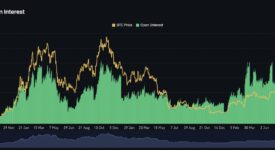
Last week, crypto bulls were confident Bitcoin (CRYPTO:BTC) would breach the support level and outshine other assets. Unfortunately, instead of rising to US$44,000, Bitcoin tumbled 7% to US$39,501.88 on March 6, 2022. On the other hand, stocks showed more resiliency as the S&P/TSX Composite Index advanced triple digits to end the week higher.
Analysts in the cryptocurrency market now say there’s potential for higher volatility in March. With BTC’s price range capped between US$30,000 and US$69,000, the price swings could be wild in a wide trading zone. Meanwhile, Canada’s primary stock benchmark rose to the occasion and extended its year-to-date gain to 0.85%.
Wild ride
Many investors fear missing out on outsized gains, given BTC’s 303.2% total return in 2020, the first COVID year. The price then rose 111.2% from the start of 2021 to US$61,243.09 on March 13, 2021. BTC went downhill beginning in mid-April 2021 before dropping below US$35,000 on July 1, 2021.
BTC gained traction once more in the ensuing months, reaching an all-time high of US$67,566.83 on November 8, 2021. Rabid followers created a hype, predicting an ascent to US$100,000. But in a sudden twist, the December flash-crash happened to start the crypto winter.
Fast-forward to February 2022, and Bitcoin produced positive returns. Historically, the crypto delivers gains in the second month of every year since 2009. However, as of this writing, BTC is losing by 14.7% year to date. While most cryptos rose due to the ongoing Russia-Ukraine war, crypto experts say they can’t be used by a government to evade economic sanctions.
Assets with no fundamentals are risky
The weekend drubbing shouldn’t be a surprise anymore because extreme volatility is Bitcoin’s trademark. The world’s most popular cryptocurrency is showing that it’s far from being “digital gold” or a store of value. Unlike stocks, BTC isn’t backed by underlying assets and, therefore, it has no intrinsic value.
Moreover, BTC’s ridiculously volatile nature stems from the lack of fundamentals. Speculation or sentiment drive the price higher, nothing more. If you own Bitcoin today, you can only hope that someone buys it higher than your purchase price. Hence, your chances of losing money are the same as the probability of gains.
Stock prices spike and dip depending on the performance of companies during good and bad times. However, a depressed stock recovers once the company returns to profitability. Because of quarterly reporting requirements, investors have a basis for making well-informed decisions before investing. With BTC and other cryptocurrencies, you have to rely on the whims of buyers and sellers.
The real drawback of BTC is zero protection for investors. Stock exchanges are regulated and have a strong long-term record. Some stocks retain their values despite the market turbulence. Exchange-traded funds are also available for diversification and risk mitigation.
Not a buying opportunity
Bitcoin is for investors with high-risk appetites. Avoid the crypto if you can’t afford to lose your money. If you insist on having exposure to the cryptocurrency market, a small position will do. The losses won’t be significant should the price tank. Note, however, the attention BTC is getting now is not a buying opportunity.



